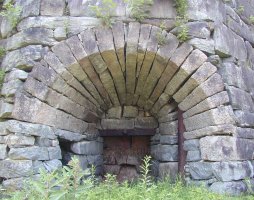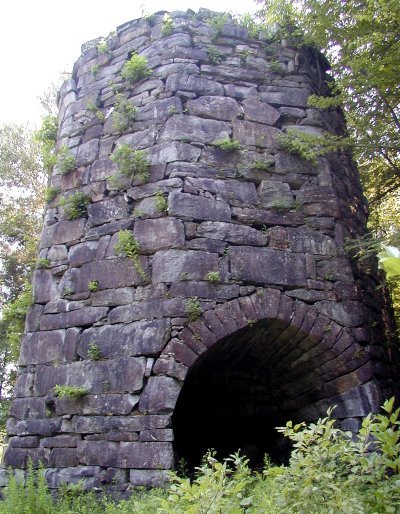New Hampshire Iron
Today, an old iron works hidden in the tall grass. The University of Houston's College of Engineering presents this series about the machines that make our civilization run, and the people whose ingenuity created them.
I turn into a rural New Hampshire road. A driver on his way out says, "You can't go in here; it's private." "I'm looking for the old ironworks," I tell him. "Yes, that's on my property," he answers. We chat for a bit. He sizes me up. Then he says, "Go on up to the house. Tell my wife I said you could go see it."
His wife takes me to a wall of underbrush and says, "Go in and follow the bend of the river." I enter with my arms lifted to avoid being scratched, and plow ahead, unable to see in any direction but up. I'm about to give up when the tall weeds part and a structure like a decaying medieval castle magically appears before me.
This was the first iron smelter in New Hampshire -- a forty-foot octagonal tower of unmortared stone. A bottle-shaped hole runs its vertical length. Once that hole was lined with firebrick. In it was stoked a terribly hot charcoal fire, sustained by pressurized air piped in at the bottom while batches of charcoal and iron ore were fed in from the top.
 A Roman-style archway leads in toward the center from four of the eight sides. Each is large enough to be a one-car garage. They connect to a hole where the smelted iron can run out and spread into small pits and solidify into lumps called pigs. The daily output of this huge smelter was two-and-a-half tons of pig iron. That took four tons of ore and twenty tons of charcoal.
A Roman-style archway leads in toward the center from four of the eight sides. Each is large enough to be a one-car garage. They connect to a hole where the smelted iron can run out and spread into small pits and solidify into lumps called pigs. The daily output of this huge smelter was two-and-a-half tons of pig iron. That took four tons of ore and twenty tons of charcoal.
The raw pig iron sold for two cents a pound. Iron that was cast in its final form in a mold cost five cents a pound. In 1838 the company turned a typical profit of eight thousand dollars.
Iron was found in central New Hampshire in 1805. Soon after, a group of Massachusetts investors set up this ironworks. Housed in a large wooden building, it was once a major feature beside the small river. It lasted until maybe 1860. (We aren't exactly sure, since records are so scanty.) Two factors led to its end. One was the dependence on charcoal. As the area around it was deforested, the advantage of coal over wood became clear. The other factor was Henry Bessemer's efficient new steel-making process, invented in 1855. After that, America rapidly moved away from small cast-iron works like this and began making steel on a large scale.
Now you can buy maple syrup across the street or visit an old museum of 19th-century farm life. The owner of the ironworks is setting up a bed and breakfast. The air is clear and quiet. It's a nice place indeed. But look closely and you see the riverbank is built up from old iron tailings. William Blake wrote these disturbing lines about the same time this smelter was put up.
And did the Countenance Divine
Shine forth upon our clouded hills?
And was Jerusalem builded here
Among these dark Satanic mills?
Well, I suppose it did look pretty Satanic once. Now it just seems so impossibly out-of-place amidst all the tangled forest vegetation.
I'm John Lienhard, at the University of Houston, where we're interested in the way inventive minds work.
(Theme music)
Aldrich, R. W., The Iron Industry in Franconia & Sugar Hill. Littleton, NH: Sherwin Dodge Printers, 1996.
Note added on 10/15/2025: This smelter, the Franconia Iron Works, is now a public museum. See Franconia Iron Furnace See also this source for its history.
For more on early American iron-making see Episode 1317.
